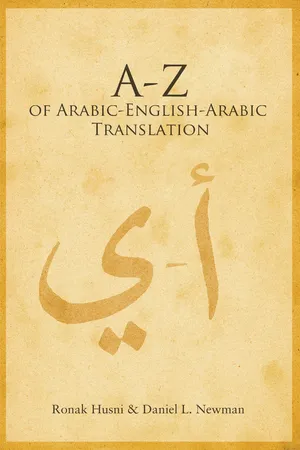
- 309 pages
- English
- ePUB (mobile friendly)
- Available on iOS & Android
A to Z of Arabic-English-Arabic Translation
About This Book
The A to Z highlights common pitfalls faced by translators working on both Arabic-English and English-Arabic texts. Each translation problem is carefully contextualized and illustrated with examples drawn from contemporary literature and the media. Using a comparative analysis approach, the authors discuss grammatical, lexical and semantic translation issues, and offer guidance regarding correct and idiomatic usage. A much-needed addition to the field for university-level students of translation and professional translators alike, the A to Z has been designed with a view to •developing and honing skills in translating between Arabic and English •enhancing idiomatic expression in both languages; •raising awareness of problems specific to Arabic-English and English-Arabic translation; •increasing competency by providing appropriate strategies for effective translation. Alphabetic arrangement of the entries ensures ease of use as both a manual and a reference work. As such, the A to Z is eminently suited for both independent and classroom use..
Frequently asked questions
Information
Abbreviations/acronyms
Table of contents
- Cover
- Title
- Contents
- Introduction
- List of abbreviations and symbols
- Abreviations/acronyms
- Beach/shore/coast/seaside
- Can/may/might
- Dare/dare say
- Each/every
- Fairly/quite/rather/pretty
- Genial/genius/genuine/ingenious/ingenuous
- Hal
- If/whether
- Judicial/judicious/judiciary/judicature
- Keep on ...
- Lawyer/solicitor/barrister
- Make/do
- Nevertheless/notwithstanding
- Obligation
- The passive
- Relative pronouns
- Say/tell
- Terms of address
- Until/till/by
- Wa and fa
- Appendix I: Tenses
- Appendix II: Modality
- English Index
- Arabic Index
- Copyright